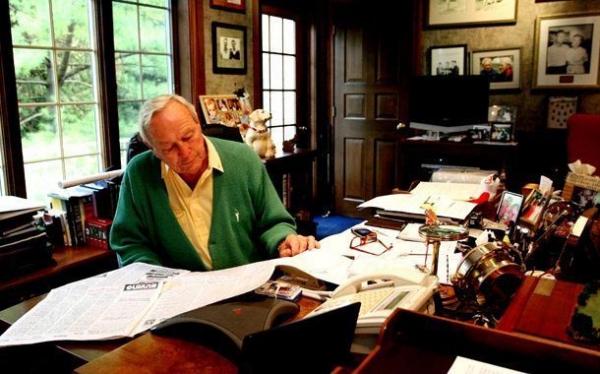When it came to building a worldwide design empire on the basis of his fame, Arnold Palmer succeeded like nobody else. Palmer, who died Sunday at age 87, was a smart-enough businessman to know that his clients would be thrilled even if he were to show up only at the occasional ceremonial event to bless work that was well underway.
 He cared enough to monitor progress on the 306 design projects that came his way during the last half-century of his life. He also knew the key was to hire good associates and to entrust and empower them. He assembled a deep roster, notably Frank Duane, Ed Seay, Harrison Minchew, Erik Larsen, Vicki Martz and, more recently, Thad Layton and Brandon Johnson.
He cared enough to monitor progress on the 306 design projects that came his way during the last half-century of his life. He also knew the key was to hire good associates and to entrust and empower them. He assembled a deep roster, notably Frank Duane, Ed Seay, Harrison Minchew, Erik Larsen, Vicki Martz and, more recently, Thad Layton and Brandon Johnson.Nobody mistook Palmer for the architect. At news conferences and ribbon cuttings, Palmer would defer to his design associates to provide technical details. Such is the confidence when you're The King.
There also was no other way to undertake the flood of work that came his way. What began as one of many ancillary businesses along with a string of dry cleaners and an eponymous drink combining iced tea and lemonade was little more than a vanity enterprise. It quickly grew to a point in the mid-to-late 1990s that the offices of Palmer's design firm in Ponte Vedra Beach, Florida., arguably were the busiest in the world, with 25 employees churning out plans and overseeing work, with little hope of catching up on the backlog.

Back then, a 30-foot long "Current Projects" board in one design studio tracked the status of 38 courses in various stages of Phase I (planning and routing); Phase II (construction documentation); and Phase III (actual construction) across 14 states and eight countries. Seven other signed contracts were in some version of "hold," if not for environmental-permitting issues then simply because of financing shortfalls. There also was a list of two dozen good prospects for which contacts had been made, business plans discussed and preliminary negotiations underway.
Those were the days. More recently, the Arnold Palmer Design Co.'s workload, like that of the entire golf industry, slowed to a near crawl. His design staff has been trimmed to two full-time designers, Layton and Johnson, and the workload handled easily in a small office at Palmer's beloved Bay Hill Resort & Lodge in Orlando, a 1962 Dick Wilson design that Palmer owns. He repeatedly tweaked the layout so that it remained a fresh test for resort guests and the toughest crowd of all to please, his fellow professionals who, starting in 1979, assembled there every March for a PGA Tour event that honored Palmer. The course used to favor aerial bombardment. Interestingly, there's now more ground game out there, including low-cut approaches and greenside rollouts into chipping areas.
His design legacy embraces 37 U.S. states, 25 countries and five continents (all except Africa and Antarctica). His first project was the back nine at his boyhood home course, Latrobe (Pa.) Country Club, with his dad, Deacon Palmer, in 1963. His last was Fazenda Boa Vista in Sorocaba, Brazil. He as an ambassador for the game all the way, never more so than in 1985 when he debuted the first course in China, Chung Shan Hot Spring Golf Club, just inland from Macau.
Palmer's design style evolved with the golf-development market. His early designs emphasized elaborately shaped bunkering and the occasional photogenic beach bunker or bulk-headed peninsula green. Gradually, he cultivated a more site-specific approach. Isleworth in Orlando, Fla., was a flat grove when Palmer and Seay went to work there in the mid-1980s. Semiahmoo in Blaine, Wash., on the Canadian border, was carved through the rolling terrain of a dense conifer forest.
At Tralee in Ardfert, Ireland, the task was less to build holes than to allow them to emerge naturally from native sand dunes on a peninsula projecting into Tralee Bay. And at PGA West (Palmer Private) in La Quinta, Calif., Palmer emulated the high-tech glitz that was the rage then with hyperactive putting surfaces, tightly fortified green complexes and four dramatic holes on the back nine into raw mountain rock.
But Palmer's design team also was capable of scaling it back, which is what makes his most highly ranked course, Old Tabby Links on Spring Island in Okatie, S.C. so impressive. The 1,200-acre site is a low-lying old tabby ruin in the middle of Intracoastal Waterway tidal marshland. There can't be more than 4 feet of natural elevation change on site. Two-thirds of the entire property are set aside for a nature preserve, and the golf course weaves in and through boggy terrain and sandy waste areas without much hint of real estate anywhere. The back nine culminates in holes that brush up against the marsh, with the now-famous 17th hole a par-3 sitting on an isthmus. As an engineering achievement, it's a brilliant piece of drainage. As golf design, it's endlessly fascinating for the angles of play and the way different long views open, depending upon the line of approach.
Palmer was respected by his peers in the American Society of Golf Course Architects. They awarded him their Donald Ross Award for lifetime achievement in 1999 and made him an honorary member and subsequently a group fellow. It didn't matter that he wasn't technically trained in topographic analysis and landscape engineering. What mattered was Palmer's commitment to a professional design ethic through the people he empowered in his firm and through his professional credibility as the game's preeminent spokesman for half a century.
- Bradley S. Klein, Golfweek
Arnold Palmer's best designs
- Kapalua Golf Club (Bay Course), Maui, Hawaii (1974)
- Whistler Golf Club, Whistler, British Columbia (1980)
- Tralee Golf Club, Ardfert, Ireland (1984)
- Chung Shan Hot Spring Golf Club, Zhongshan, China (1985)
- Isleworth Golf & Country Club, Orlando, Fla. (1986)
- Semiahmoo Golf & Country Club, Blaine, Wash. (1986)
- PGA West (Palmer Private), La Quinta, Calif. (1987)
- Kildare Hotel & Country Club (Smurfit), Straffan, Ireland (1990)
- Park Hyatt Aviara Golf Club, Carlsbad, Calif. (1990)
- Dakota Dunes Country Club, Dakota Dunes, S.D. (1991)
- Musgrove Mill Golf Course, Clinton, S.C. (1992)
- Old Tabby Links on Spring Island, Okatie, S.C. (1994)
- Oasis Golf Club (Palmer Course), Mesquite, Nev. (1995)
- Running Y Ranch Resort, Klamath Falls, Ore. (1997)
- Tradition Golf Club, La Quinta, Calif. (1998)
- ArborLinks Golf Course, Nebraska City, Neb. (2001)
- TPC Boston, Norton, Mass. (2002)
- Reunion Resort & Club (Legacy), Kissimmee, Fla. (2003)
- Newport Dunes, Port Aransas, Texas (2008)
- Fasano Las Piedras, Punta del Este, Uruguay (2012)

